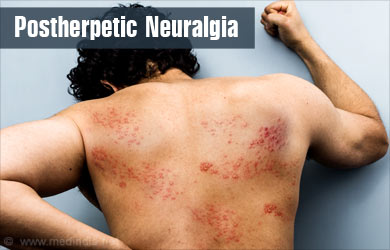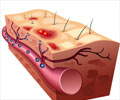- Zoster-Associated Pain and Post Herpetic Neuralgia - (http://cdn.intechopen.com/pdfs-wm/31263.pdf)
- Armando S, Nicoletta V, Sara P, Matilde G, Silvia L, et al. (2015) Herpes Zoster: New Preventive Perspectives. J Dermatolog Clin Res 3(1): 1042.
- Shingles Information Page - (http://www.ninds.nih.gov/disorders/shingles/shingles.htm)
What is Postherpetic Neuralgia?
The pain occurs in the same dermatomic area of the skin where the rash initially occurred. This condition can cause a lot of physical discomforts and interfere with daily functioning.
Chicken pox is a common infection that occurs during childhood. Its occurrence has reduced with the introduction of the varicella vaccine in children. Chicken pox often subsides on its own without complications. However, the virus causing chicken pox, varicella zoster virus can remain dormant in the nerves.

Under certain circumstances like reduced immunity, it can recur during adulthood causing a condition called shingles or herpes zoster. In shingles, the patient notices a rash which consists of water-filled small lesions in a particular area of the skin on one half of the body. The doctor will notice that this area is supplied by a particular nerve root. Symptoms like pain and numbness are also often present, but may vary from mild to severe.
Postherpetic neuralgia is a complication of shingles in which the patient experiences pain along the distribution of the nerve, well after the rash has subsided. Such a pain usually lasts for at least 3 months following the recovery from the rash and this is defined as postherpetic neuralgia.
Risk factors that appear to increase the chances of postherpetic neuralgia include:
- Older age: Postherpetic neuralgia is common over the age of 60 years and becomes even more common over the age of 80 years.
- Pain present at the time of rash.
- Increased severity of rash.
- Presence of nerve-related symptoms like pain, or abnormal sensations before the appearance of the rash.
What are the Symptoms of Postherpetic Neuralgia?
Characteristics of the pain include:
- Burning, throbbing, lancinating pain or an electric shock-like pain along the distribution of the affected nerve.
- The pain may be continuous or intermittent with relief periods between the pain.
- The pain may be associated with excessive sensitivity to painful or non-painful stimulus.
How to Diagnose Postherpetic Neuralgia?
Postherpetic neuralgia is diagnosed based on:
- History of the patient, who may indicate that he/she had an attack of shingles in the recent past.
- Physical examination which may not reveal much since the rash will have subsided. However, scars of the rash may be noticeable.
The degree of pain is assessed using various questionnaires where the patient is asked to rate the degree of pain.
What are the Treatments for Postherpetic Neuralgia?
Whether these drugs can avoid or reduce the chances of postherpetic neuralgia developing later is uncertain.
Several drugs have been tried and are being used in the treatment of postherpetic neuralgia. These include:
- Lidocaine patches which have a local anesthetic effect.
- Tricyclic antidepressants like amitriptyline, nortriptyline and desipramine, and antiepileptics like pregabalin and gabapentin. These reduce nerve transmission, and thereby reduce pain.

- Opioids like tramadol which act as painkillers.
- Capsaicin creams / patches, which act locally on the nerves.
- Nerve blocks which may be used in cases not responding to any other treatment. Some surgical procedures like deep brain stimulation have also been tried out.
- Acupuncture has also been tried out in cases of postherpetic neuralgia.
Health Tips
- Continuous pain from postherpetic neuralgia can be depressing for the patient. Therefore, the patient may require psychological support during this time.
- The patient may not be able to carry out his/her routine duties and therefore may need a caregiver. It should be remembered that most of these patients belong to the older age group.
- Vaccination against varicella in older individuals could result in milder infections and could possibly prevent postherpetic neuralgia. Vaccination is approved in individuals over the age of 50 in the US and the UK.
- Acupuncture is also an option to treat postherpetic neuralgia in those who do not want to take medications or do not respond well to medications.








